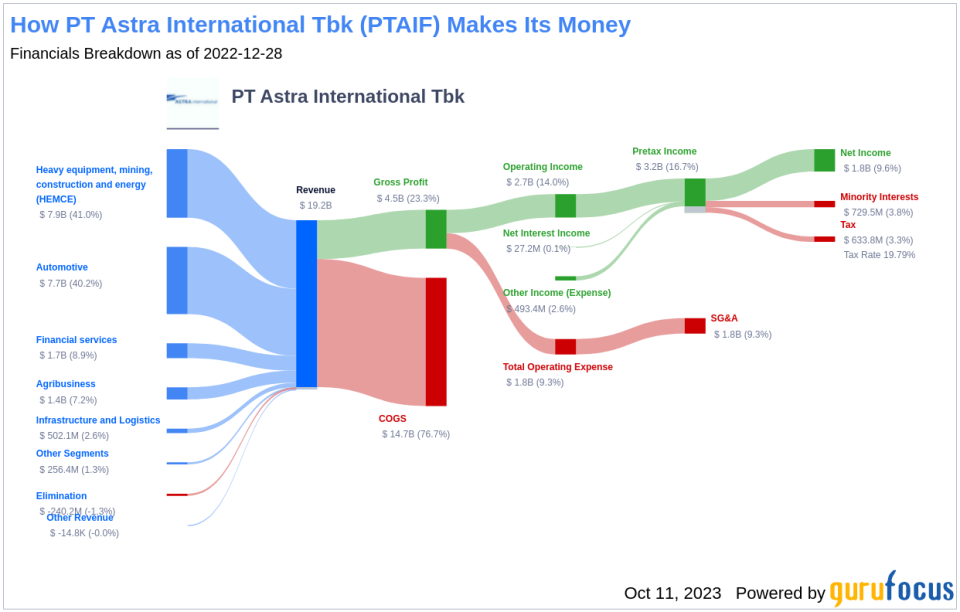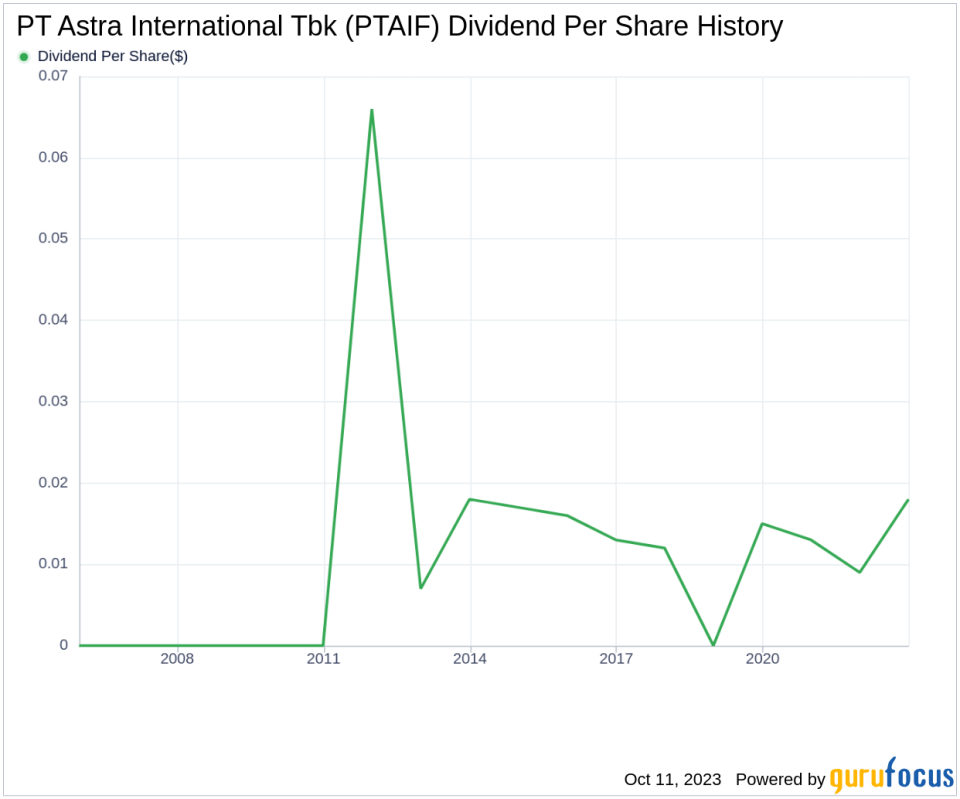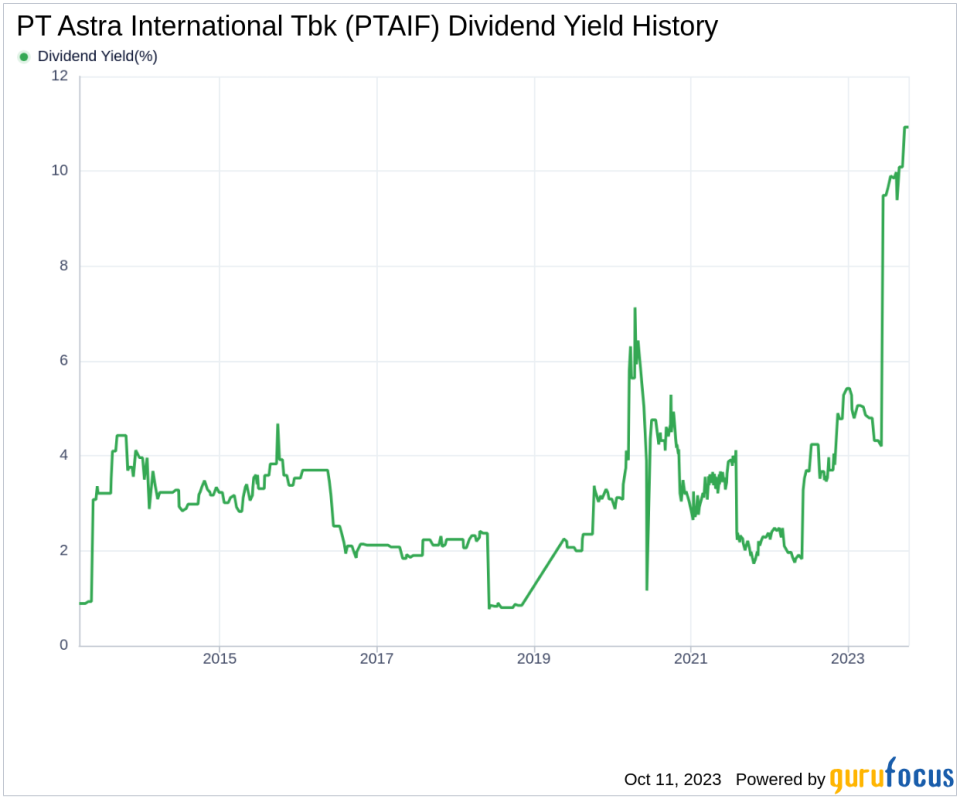PT Astra International Tbk's Dividend Analysis
An In-depth Look at PT Astra International Tbk's Dividend Performance and Sustainability
PT Astra International Tbk (PTAIF) recently announced a dividend of $98 per share, payable on 2023-10-31, with the ex-dividend date set for 2023-10-12. As investors look forward to this upcoming payment, the spotlight also shines on the company's dividend history, yield, and growth rates. Using the data from GuruFocus, let's delve into PT Astra International Tbk's dividend performance and assess its sustainability.
A Brief Overview of PT Astra International Tbk
This Powerful Chart Made Peter Lynch 29% A Year For 13 Years
How to calculate the intrinsic value of a stock?
PT Astra International Tbk is an Indonesia-based conglomerate operating in seven segments: Automotive, Financial Services, Heavy Equipment, Mining, Construction, and Energy (HEMCE), Agribusiness, Infrastructure and Logistics, Information Technology, and Property. The company offers a variety of car brands, including Toyota, Daihatsu, Isuzu, BMW, Peugeot, UD Trucks, and Honda motorcycles, and provides car maintenance and services via its distribution network. Financial services support the financing for Astra's other business segments, and the HEMCE segment includes construction machinery, mining contracting, and coal mining.
A Look at PT Astra International Tbk's Dividend History
PT Astra International Tbk has maintained a consistent dividend payment record since 2019. Dividends are currently distributed on a bi-annual basis. Below is a chart showing annual Dividends Per Share for tracking historical trends.
Understanding PT Astra International Tbk's Dividend Yield and Growth
As of today, PT Astra International Tbk currently has a 12-month trailing dividend yield of 10.93% and a 12-month forward dividend yield of 11.09%. This suggests an expectation of increased dividend payments over the next 12 months.
PT Astra International Tbk's dividend yield of 10.93% is near a 10-year high and outperforms 96.73% of global competitors in the Vehicles & Parts industry, suggesting that the company's dividend yield stands out as an attractive proposition for income investors.
Over the past three years, PT Astra International Tbk's annual dividend growth rate was 10.10%. Extended to a five-year horizon, this rate decreased to 4.00% per year. Over the past decade, PT Astra International Tbk's annual dividends per share growth rate stands at -0.70%.
Based on PT Astra International Tbk's dividend yield and five-year growth rate, the 5-year yield on cost of PT Astra International Tbk stock as of today is approximately 13.30%.
Assessing Dividend Sustainability: Payout Ratio and Profitability
To assess the sustainability of the dividend, one needs to evaluate the company's payout ratio. The dividend payout ratio provides insights into the portion of earnings the company distributes as dividends. A lower ratio suggests that the company retains a significant part of its earnings, thereby ensuring the availability of funds for future growth and unexpected downturns. As of 2023-06-30, PT Astra International Tbk's dividend payout ratio is 0.92, which may suggest that the company's dividend may not be sustainable.
PT Astra International Tbk's profitability rank, offers an understanding of the company's earnings prowess relative to its peers. GuruFocus ranks PT Astra International Tbk's profitability 7 out of 10 as of 2023-06-30, suggesting good profitability prospects. The company has reported positive net income for each year over the past decade, further solidifying its high profitability.
PT Astra International Tbk's Growth Metrics: The Future Outlook
To ensure the sustainability of dividends, a company must have robust growth metrics. PT Astra International Tbk's growth rank of 7 out of 10 suggests that the company's growth trajectory is good relative to its competitors.
Revenue is the lifeblood of any company, and PT Astra International Tbk's revenue per share, combined with the 3-year revenue growth rate, indicates a strong revenue model. PT Astra International Tbk's revenue has increased by approximately 8.30% per year on average, a rate that outperforms approximately 59.02% of global competitors.
The company's 3-year EPS growth rate showcases its capability to grow its earnings, a critical component for sustaining dividends in the long run. During the past three years, PT Astra International Tbk's earnings increased by approximately 10.10% per year on average, a rate that outperforms approximately 50.8% of global competitors.
Lastly, the company's 5-year EBITDA growth rate of 4.80%, outperforms approximately 54.27% of global competitors.
Concluding Thoughts
Despite a high payout ratio that raises concerns about the sustainability of its dividends, PT Astra International Tbk's strong growth metrics, profitability rank, and impressive dividend yield make it a compelling investment for income-seeking investors. However, investors should keep an eye on the company's payout ratio and future earnings to ensure the sustainability of its dividends in the long run.
GuruFocus Premium users can screen for high-dividend yield stocks using the High Dividend Yield Screener.
This article, generated by GuruFocus, is designed to provide general insights and is not tailored financial advice. Our commentary is rooted in historical data and analyst projections, utilizing an impartial methodology, and is not intended to serve as specific investment guidance. It does not formulate a recommendation to purchase or divest any stock and does not consider individual investment objectives or financial circumstances. Our objective is to deliver long-term, fundamental data-driven analysis. Be aware that our analysis might not incorporate the most recent, price-sensitive company announcements or qualitative information. GuruFocus holds no position in the stocks mentioned herein.
This article first appeared on GuruFocus.



